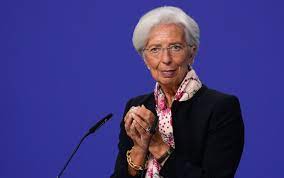Jeremy Warner
Europe is once again heading for trouble – both as an economy, and, from migration to net zero, much else besides. Isn’t it always, goes the obvious riposte to this statement. And cannot that also be said about the UK, US and China?
To which the answer is yes; they are all falling victim to the growing realisation that the last two years of rising interest rates are not just some temporary aberration. Rates are going to remain higher for longer, massively increasing the debt servicing costs of already fiscally challenged governments. Interest rates may have peaked, but over the past two weeks, central bankers have made it abundantly clear that they will not be falling significantly for some time. That came as a shock to markets, where cuts to interest rates from early next year onwards had been taken for granted. It’s been a rude awakening, with bond yields rising anew.
Only in Europe, it’s potentially rather more serious, because it still has the straitjacket of the euro to contend with. That binds together 20 fiscally sovereign countries in what more than two decades after its formation remains an only half formed and therefore fundamentally flawed monetary union. That doesn’t mean the single currency is again heading for collapse, as perhaps was the case at the height of the eurozone sovereign debt crisis back in 2009/10. Anglo-Saxon commentators constantly underestimate the degree of political will that exists in Europe to make it work, whatever the costs.
But with much higher interest rates, the fault lines are nevertheless fast re-emerging. And this time around, the European Central Bank will struggle to provide the “whatever it takes” support of limitless bond buying that saved the single currency from ruin when it was last teetering on the brink. Under no-bailout rules designed to protect more solvent eurozone members such as Germany from less creditworthy ones, fiscal deficits are meant to be limited to just 3pc of national income. Stability and Growth Pact rules also require national debt to be reduced to 60pc of GDP over time.
Scarcely anyone has been consistently compliant, and that includes Germany and France, whose various breaches of budget deficit limits have inexplicably gone unpunished and unfined. The massive European Central Bank bond buying programme initiated by Mario Draghi in the summer of 2012 to save the euro from oblivion seemed in any case to make the no-bailout clauses of the Maastricht Treaty largely irrelevant, since it amounted to monetisation and therefore mutualisation of government debt mountains.
All the same, the pretence of fiscal discipline persisted – until the pandemic, that is, when the Stability and Growth Pact rules were suspended to allow nation states to spend at will to support lockdown. Plans to reimpose the pact at the end of last year were then derailed by war in Ukraine, and the huge energy price subsidies that governments across Europe put in place to protect citizens from its inflationary consequences. So the deadline was again extended, to the end of this year. Fat chance.
As was always likely to be the case, once the floodgates had been opened, they are now proving very hard to close. In budget plans announced last week, both Italy and France have made it more than clear that they have no intention of making the spending cuts needed to bring deficits into line with the demands of the Maastricht criteria.
In outright defiance, Italy’s finance minister, Giancarlo Giorgetti, said last week: “We believe we have done the right things. We don’t respect the 3pc limit.” Indeed they do not. Determination to proceed with election pledges to cut taxes will see the 2023 deficit surge to 5.3pc of GDP, compared with previous estimates of 4.5pc. For 2024, the deficit improves only marginally to 4.3pc. It’s as if Italy’s firebrand prime minister, Georgia Meloni, has transmogrified into Liz Truss. To hell with the constraints of fiscal rules; she’s going for growth, and appears determined to resist the recessionary forces of imposed fiscal contraction.
Similarly France, which has backed away from the sort of spending cuts needed to get the deficit under control. They are not the only ones. It is estimated that at least a half of eurozone members won’t meet the 3pc limit next year. Yields have leapt, and spreads widened, in the case of Italy back to the level that ruled in the wake of America’s mini-banking crisis earlier this year. All of a sudden credit risk is back on the table.
Despite slightly higher growth than much of the rest of Europe, Britain is scarcely immune either. Higher interest rates have sent the Government’s debt servicing costs, now running at their highest level since the immediate aftermath of the Second World War both as a share of GDP and government revenue, through the roof. Yet the UK does at least have its own currency to act as a natural adjustment mechanism. Some of the squeeze from “higher for longer” can be absorbed through a lower exchange rate. There is no such relief available in the eurozone, where powerful recessionary forces are closing in on all sides, especially in the industrial heartlands of Germany.
The curiosity here is that unlike Italy and France, Germany has got more than enough fiscal space to counter a shrinking economy with tax cuts and spending increases. As has been well documented, Germany desperately needs to address an increasingly decrepit backbone infrastructure, and yet still it skimps on investment spending. Germany’s ruling coalition government shows little or no inclination to break with the political consensus around “black zero”, or running balanced budgets. Indeed, as things stand, fiscal policy is set to tighten further straight into the teeth of a contracting economy.
As for higher interest rates, bring them on. That seems to be the almost masochistic attitude of Berlin’s high command. Low interest rates are for sissies, Olaf Scholz, the German Chancellor, seemed to say at a recent rally. Back in the 1970s, we built loads of housing with interest rates at 9.5pc, he boasted. “Money was saved back then. Interest rates are not the problem”. Only they sort of are, because although ultra easy monetary policy helped save the euro from destruction more than a decade ago, rising inflation has closed off those options this time around, and now there is only the debt fueled fiscal incontinence of Germany’s neighbours to keep the recessionary wolf from the door. It remains to be seen just how tolerant Germans are prepared to be. Judging by the progress Alternative for Germany is making in the polls, not very may well be the answer. In any case, higher-for-longer is once again threatening to reignite Europe’s centrifugal forces.







